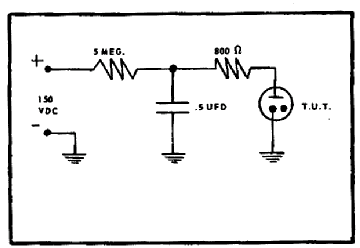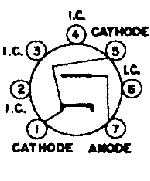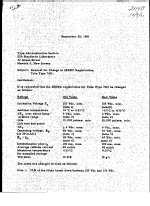
TD-36A
|
|
|||||||||||||||||||||||||||||||||||
|
Hits: 3092 Replies: 4
Bendix TD-36A, what is this tube?
|
|
|
Giuseppe Feniello
01.May.13 |
1
Hallo to all the radiofriends, recently I found a tube with the same size as a 6J6, manufactured by Bendix and type number "TD-36A", it has the radioactive mark on the glass near the type number, does someone know it ? the use of this tube, the datasheet? thanks in advance for helping me. Attached a photograph of this tube. Best regards. Giuseppe. Attachments
|
|
Emilio Ciardiello
01.May.13 |
2
Giuseppe, the TD-36 and the TD-36A were gas diodes with accurate firing point over a wide temperature range. They were intended for use in RC relaxation oscillators, energy transfer gates or protective devices. TD-36A was more accurate than TD-36, specufied for a spread of the firing voltage under 2 VDC over a temperature range from -55° to +135°C. In the time both were equivalent to the JEDEC code 7416. Just created their codes and added all the available info. You can add the photo to the TD-36A. Emilio |
|
Giuseppe Feniello
02.May.13 |
3
Hello Mr Emilio, many thanks for the answer, but what about the radioactive mark on the tube ? Is It dangerous to keep it ? On a web site I found it is filled by Cesium 137 !! Do you advise me to throw it away ? best regards. Giuseppe. |
|
Emilio Ciardiello
02.May.13 |
4
Dear Giuseppe, almost all gas filled tubes intended for operation over an extended temperature range contain radioactive activators, in form of gas molecules or salts. Activators stabilize the ionization threshold, otherwise difficult at very low temperatures. Radioactive devices include spark gaps, T/R switches and even most of the military voltage regulators since WWII. Probably many of the tubes made during the war and, for some Countries, even well in the fifties contains radioactive activators, even if the warning symbol is missing. I remember the ads of the Berkley University on some Electronics of the fiifties, listing a lot of radioactive materials for the electronic industry. In many cases the activator material and the radiation level are printed on the box and even on the tube. I guess that these tubes are not really harmful if not broken, especially if safely stored far from our living rooms. Consider that if you are planning to simply throw it away, you are about committing a very serious crime against the environment. These tubes are to be disposed of only by authorized companies. If you have any fear, please contact me on my email address. Anyway every collector of tubes of electronic gears usually stores huge quantities of harmuful and today banned materials, asbestos, beryllium, mercury, lead, cadmium, just to name the most known. Of other materials, as the titanium hydride usually found in hydrogen thyratrons, is even difficult to know how harmful they can be. Emilio |
|
Giuseppe Feniello
03.May.13 |
5
Dear Mr Emilio, thanks for the very clear and expert answer, do not worry about, when I say "throw away" this tube I mean to give it to an authorized relevant and recognized by the law authority that can handle such materials like "viglili del fuoco" or ASL. If someone in this forum want this tube I can give it.... Thanks again, best regards. Giuseppe |
End of forum contributions about this tube
| Data Compliance | More Information |





